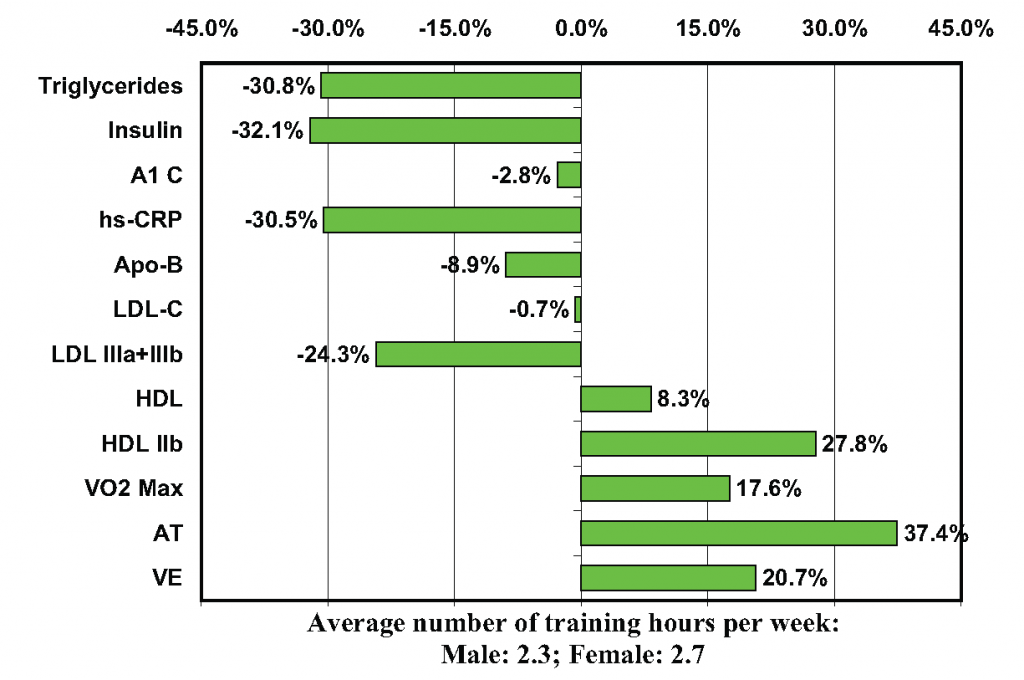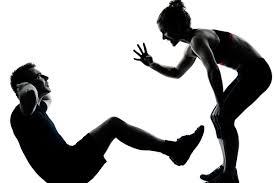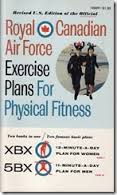This is the epilog to the exercise program. It consists of various philosophical remarks, and general cheerleading

The is the 7th and last (for a while, at least) in the exercise series. Joint maintenance was discussed here, balance and neurogenesis here, osteoporosis prevention here. heart rate variability here, and biological power here.
Based on the comments we got, it looks like a lot of people have a lot of good exercises that would fit well in the program. Besides describing the exercises, we also described how and why they work. Hopefully, armed with this, you can cook up all sorts on your own.
Going for the Gold
The Tier One exercises, done in a WECMC fashion, will most likely improve your biological power to the maximal extent possible. The chart again shows the six-month results from the initial group.

These were not Olympic trainees. Generally, these people were already sick or headed in that direction.
These 25 people were highly monitored, with quarterly blood tests, their heart rates monitored and recorded. Every exercise session was supervised by a trainer as well. Of necessity, many of them started slowly and step-by-step, as outlined above. Nonetheless, by six months all these people’s health had dramatically improved. Most had reversed at least one degenerative disease. Some had reversed several. The trainer presence insured that the exercises were done, and done right, and the measurements verified the results, but it was the 25 people themselves who did all the work, who, in effect, cured themselves. This level of improvement is available to anyone who performs the exercises with the power and form required. It would definitely help to engage a trainer, but make sure the trainer has a good grasp of the exercise components. Just look at the results.
The route to attaining and maintaining peak health requires some work, discipline, and dedication. It does not require inordinate amounts of time though, and it seems to us that the benefits hugely out weight the “costs.”
The principal point is to keep challenging yourself. This, in turn, continually challenges your body to do more, and do it more effectively, maintaining and increasing your biological power. This does not mean spending half your life at the gym. What it does mean is keeping the exercises challenging. When you have mastered standing on a wobbly object with two feet, learn to do it with one. Employ more “WECMC” in the resistance type exercises. Keep pushing yourself. If the demand is there and time for recovery is allowed, the body will respond.
ASSORTED EXERCISE TOPICS
Here are several generally useful exercise tips.
Picking a Gym
The most important criterion is that you feel comfortable and welcome. The main reason for doing so is health, and a gym that focuses on that would be desirable. The YMCA gyms do well in this regard, plus they are reasonably priced and don’t try to pressure you into long-term deals. Also the YMCA trainers will show you the safe way to do an exercise, usually for free. For squats and deadlifts this is quite important.
If you like classes, by all means do classes. Many do not seem to emphasize resistance or interval training, but there are notable exceptions.
Strenuous classes like exercise programs that emphasize balance and heart rate variability, such as the Bar Method, are excellent.
One important machine to look for is the rower. The “standard” brand is the Concept2. Most gyms have these. The rower is a very safe and effective way to do interval and anaerobic-threshold exercise. However, there are many other ways, so lack of a rower needn’t be a showstopper.
Another essential gym item would be a squat cage, which is a rack that allows you to load weights onto a barbell, along with safety rails to catch the bar should you fall or take on too much weight. Gyms usually have one.
Trainers
Unless the staff will instruct you for free, you should buy a few trainer sessions and have the trainer show you the safe way to do these exercises, especially squats and deadlifts. Not all trainers have the same ideas. Be sure to watch the exercise videos on QuantitativeMedicien.net too.
Trainers vary. Some primarily function as cheerleaders. Others provide serious medical benefits to their trainees (you).
Other than safety issues, you do not absolutely need a trainer. However, the exercise benefits will probably roll in twice as fast if you can find the “right” one. But how to do this? First of all, find a trainer you can communicate with and who respects you. Explain the training protocols you are interested in and explain why. They should be interested and should not be dismissive. They should have some idea of what “whole-body, explosive, concentric, multi-planar, closed-chain” exercises are, as well as interval and anaerobic exercises. Generally speaking, they will be quite surprised that you have a definite agenda, as most of the people they deal with do not. If they seem to be unwilling to accommodate your agenda, or don’t seem to be listening, talk to someone else.
You might proceed this way: Get your introductory safety session and chat a bit about explosive and interval exercise. See if this resonates. Maybe this will lead you somewhere. Barring that, go about the gym, doing whatever routine you have thought up, and keep a sharp eye on the various training sessions going on around you. You will probably be able to spot some trainers that are practicing the style we are looking for. A good trainer will come up with a huge repertoire of exercises, which will make the sessions more interesting, and will give all your various muscles and joints their day in the sun.
Normally gyms want you to buy a package of training sessions. Try to avoid this at until you are happy with your trainer.
Alternatives
We have recommended that you join a gym, and that you use the rowing machine for both intervals and the anaerobic exercises, and use free weights for the rest. There can be endless variations on this. For intervals and the anaerobic exercises, anything that can run your heart up will work. Running or bicycling up a steep hill would be excellent. The gym machine that looks like a tiny escalator can work too.
Here’s a venerable home program: the Royal Canadian Air Force Exercise Plan. This nugget dates from the ‘60s and is done entirely as calisthenics, no weights or equipment needed. It takes 11 minutes for men and 12 minutes for women. Here’s a typical men’s list:
- Toe Touching/Warm-Up: two Minutes

- Partial Sit-Ups: one Minute
- Leg Lifts: one Minute
- Push-Ups: one Minute
- Stationary Running: 6 Minutes
The female variant:
- Toe Touching/Warm-Up: 30 Seconds
- Knee Raising: 30 Seconds
- Arm Circling: 30 Seconds
- Partial Sit-Ups: 30 Seconds
- Chest And Leg Raising: two Minutes
- Side Leg Raising: one Minute
- Push-Ups (Kneeling): two Minutes
- Leg Lifting: one Minute
- Run And Hop: 3 Minutes
These are daily exercises and are graduated. They get harder as you go along, but they still only use 11 minutes. The full booklet is easily found on-line.
If you do not feel comfortable going to a gym, it is possible to set something up in your home. The Concept II rowing machine seems to have a street price of around $800 delivered. You can install a chin-up bar. If you can’t do a full chin-up, consider pulling up from a supine position or using resistance straps.
Do something. Almost anything offers significant health improvements over “couch-potato.”
Famous Exercisers
Most Americans over 50 will remember fitness guru Jack LaLanne. He had a televised daily exercise show that started in 1953 and ran 32 years. He finally decided to call it quits in 1985 at age 71. There are on-line videos of his final show with Oprah. He is amazing. He looks 20 years younger, but you might expect that. However, he moves with the grace and agility of someone 50 years younger, and that is something to see. At an age where many are battling all sorts of mobility problems, this guy is bouncing around like a kid. He practiced what he preached, working out till the end, at age 95. In later interviews, he still had his vigor, looked years younger, and clearly had all his marbles.
Jack LaLanne was far from the only physically fit celebrity who held it together way beyond retirement age. Fred Astaire at age 80 was challenged to dance on a Dick Cavett TV show and “improvised” something with remarkable fluidity and energy. No rocking chair for that guy.
Not everyone can have Jack’s physique or Fred’s dancing feet; these are gifts. But their health, vigor, and general youthfulness are available to all who are willing to keep active, eat sensibly and take life as it comes. That part is a matter of decision and discipline, not a matter of genetic gifts.
If Exercise Is So Damn Good, Why Do Many Of Us Abhor It?
This has many dimensions. Clearly in times of scarcity, there is a survival necessity to conserve energy. In our wealthier modern times, this seldom applies to many of us. Even so, whether or not to conserve is always up to the hypothalamus, and always in the context of its ancient world-view. So energy conservation remains a factor.
We are also social beings, having spent most of our evolution in tribes and bands. A tribe will not prosper if a substantial fraction of its members are non-productive. Are we beyond reproductive age? Hunting age? Perhaps gathering age? We live substantially longer than animals of similar sizes and so do our great ape cousins. But ultimately the tribes that survived were the efficient ones, not those saddled with large, unproductive sub-groups. So we, the survivor’s descendants, may have senescence wired in as it were, along with an aversion to energy consuming exercise.
Modern times have upended all this. Most of us will get enough food. There’s no longer an energy issue. If we have saved and behaved, we needn’t be a burden for anyone. So there is no further need to turn all the dials down and wait for the twilight to end. We can, through sheer exercise of will, run up the cellular machinery to its possible peak. Run it as though we were young hunters in a time of plenty. What will happen? We will, in a sense, become young again. All these old cells still have plenty of sizzle left and will duly respond.
But this isn’t how we are programmed. Isn’t Mother Nature going to be peeved? Our choice. In the West, we live in a time of broad abundance. Maybe in 100,000 years we will have adapted to all this.
We can wait. We can choose the old ways and wind down. Or we can choose life now. We can ignite the processes that lie within. The processes of health and energy and acuity.
Once this is known and fully understood, ignoring it is as reckless as crossing a street blindfolded. The best way to come to grasp this is to measure, do a rigorous exercise program for six months, and measure again. If you did it seriously, it is almost a certainty that you have turned back your biological clock. This is a medical fact, known for millennia, yet as elusive as handfuls of sand.
Some people like to exercise. Maybe 10%-20%. And there may be people that hate sugar. The sad truth is that we don’t get to the promised land, at least not the one on this planet, unless we exercise (and manage the sugar too). So two things:
- You need to exercise.
- You need to make a lifelong commitment.
Many people, when first confronted with bad medical news, will go join a gym and with great zeal, pound away at it for, well, probably not all that long. There are good business reasons why the gyms try to get that 1-year no-cancellation commitment.
We have tried to “package” the recommended exercises so that, though intense, they are over with quickly. You can get most of the benefit from these two 45-minute sessions. You can get a bit more if you do more, but you really can’t get a lot more. Overtraining can be detrimental for a variety of reasons. You need renewal and repair time. Two 45-minute intense sessions plus an added session featuring balance, flexibility, and coordination are probably a reasonable upper limit. Pragmatically speaking, overtraining isn’t a risk for most of us.
Do something. The more it is like our recommendations, the better the result, but there is an infinity of variation that will help, many just as much as our own. The very important final takeaway: Find a program you will actually do for the rest of your life. And remember, intensity is everything. Five hours of golf is not nearly as beneficial as 11 minutes of the Royal Canadian Air Force Exercise Plan. And you will go a lot further still with our 45-minute gym sessions. No matter. Do something. No exercise at all is a formula for disaster.
Do not get disheartened. A lifetime commitment is needed. As you slog through it all, keep telling yourself:
- Risk of heart attack is cut at least in half, maybe a lot more.
- Resistance exercise done correctly, can completely prevent or reverse osteoporosis.
- Exercise raises HDL. This alone cuts cancer risk by as much as 50%.
- Exercise acts as an antidepressant.
- Exercise reduces the risk of dementia 50% or more.
- Exercise will cause the short-term memory regions of your brain to grow.
- Exercise raises IGF-1 and testosterone, thus increasing anabolism and cellular repair and renewal.
And enjoy the long, disease free life you are creating for yourself.
Epilog to the Epilog
These words of wisdom date from 1832, found in “A Treatise on the Cure and Prevention of Disease,” by one William Buchan, M.D. A similar message was given by Hippocrates some 2,000 years earlier.
Exercise and stay well. No indolence allowed.

